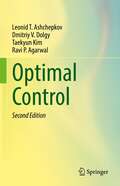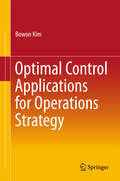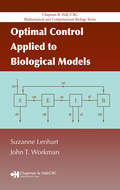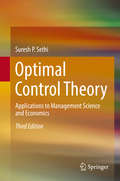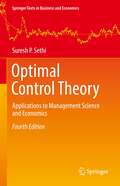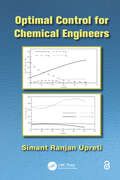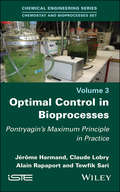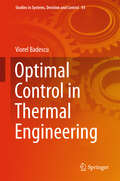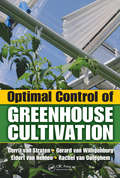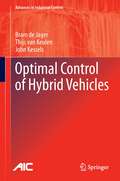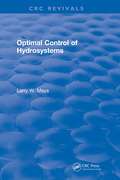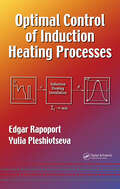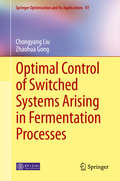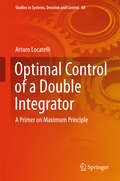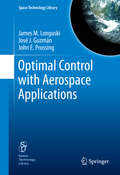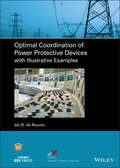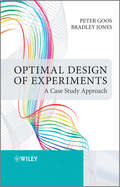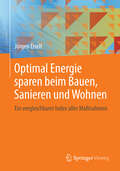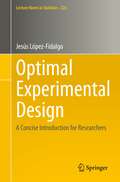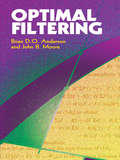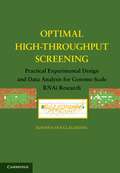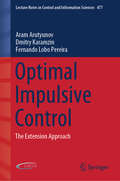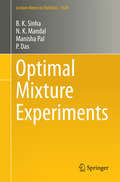- Table View
- List View
Optimal Control
by Ravi P. Agarwal Dmitriy V. Dolgy Taekyun Kim Leonid T. AshchepkovThis textbook, now in its second edition, results from lectures, practical problems, and workshops on Optimal Control, given by the authors at Irkutsk State University, Far Eastern Federal University (both in Vladivostok, Russia), and Kwangwoon University (Seoul, South Korea).In this work, the authors cover the theory of linear and nonlinear systems, touching on the basic problem of establishing the necessary and sufficient conditions of optimal processes. Readers will find two new chapters, with results of potential interest to researchers with a focus on the theory of optimal control, as well as to those interested in applications in Engineering and related sciences. In addition, several improvements have been made through the text.This book is structured in three parts. Part I starts with a gentle introduction to the basic concepts in Optimal Control. In Part II, the theory of linear control systems is constructed on the basis of the separation theorem and the concept of a reachability set. The authors prove the closure of reachability set in the class of piecewise continuous controls and touch on the problems of controllability, observability, identification, performance, and terminal control. Part III, in its turn, is devoted to nonlinear control systems. Using the method of variations and the Lagrange multipliers rule of nonlinear problems, the authors prove the Pontryagin maximum principle for problems with mobile ends of trajectories. Problem sets at the end of chapters and a list of additional tasks, provided in the appendix, are offered for students seeking to master the subject. The exercises have been chosen not only as a way to assimilate the theory but also as to induct the application of such knowledge in more advanced problems.
Optimal Control Applications for Operations Strategy
by Bowon KimThis book focuses on the applications of optimal control theory to operations strategy and supply chain management. It emphasizes the importance of optimal control theory as a tool to analyze and understand fundamental issues in the respective fields. Delving deeper, the book also elaborates on how optimal control theory provides managerial and economic insights, enabling readers to comprehend the dynamic activities and interactions in operations. Given that optimal control theory is not a dominant approach to studying operations management in the current literature, this book fills that gap by showing its effectiveness as a tool to supplement other methodologies in operations.
Optimal Control Applied to Biological Models (Chapman & Hall/CRC Mathematical Biology Series)
by Suzanne Lenhart John T. WorkmanFrom economics and business to the biological sciences to physics and engineering, professionals successfully use the powerful mathematical tool of optimal control to make management and strategy decisions. Optimal Control Applied to Biological Models thoroughly develops the mathematical aspects of optimal control theory and provides insight into t
Optimal Control Theory and Static Optimization in Economics
by Daniel Leonard Ngo Van LongOptimal control theory is a technique being used increasingly by academic economists to study problems involving optimal decisions in a multi-period framework. This book is designed to make the difficult subject of optimal control theory easily accessible to economists while at the same time maintaining rigor. Economic intuition is emphasized, examples and problem sets covering a wide range of applications in economics are provided, theorems are clearly stated and their proofs are carefully explained. The development of the text is gradual and fully integrated, beginning with the simple formulations and progressing to advanced topics. Optimal control theory is introduced directly, without recourse to the calculus of variations, and the connection with the latter and with dynamic programming is explained in a separate chapter. Also, the book draws the parallel between optimal control theory and static optimization. No previous knowledge of differential equations is required.
Optimal Control Theory: Applications to Management Science and Economics
by Suresh P. SethiThis fully revised 3rd edition offers an introduction to optimal control theory and its diverse applications in management science and economics. It brings to students the concept of the maximum principle in continuous, as well as discrete, time by using dynamic programming and Kuhn-Tucker theory. While some mathematical background is needed, the emphasis of the book is not on mathematical rigor, but on modeling realistic situations faced in business and economics. The book exploits optimal control theory to the functional areas of management including finance, production and marketing and to economics of growth and of natural resources. In addition, this new edition features materials on stochastic Nash and Stackelberg differential games and an adverse selection model in the principal-agent framework. The book provides exercises for each chapter and answers to selected exercises to help deepen the understanding of the material presented. Also included are appendices comprised of supplementary material on the solution of differential equations, the calculus of variations and its relationships to the maximum principle, and special topics including the Kalman filter, certainty equivalence, singular control, a global saddle point theorem, Sethi-Skiba points, and distributed parameter systems.Optimal control methods are used to determine optimal ways to control a dynamic system. The theoretical work in this field serves as a foundation for the book, which the author has applied to business management problems developed from his research and classroom instruction. The new edition has been completely refined and brought up to date. Ultimately this should continue to be a valuable resource for graduate courses on applied optimal control theory, but also for financial and industrial engineers, economists, and operational researchers concerned with the application of dynamic optimization in their fields.
Optimal Control Theory: Applications to Management Science and Economics (Springer Texts in Business and Economics)
by Suresh P. SethiThis new 4th edition offers an introduction to optimal control theory and its diverse applications in management science and economics. It introduces students to the concept of the maximum principle in continuous (as well as discrete) time by combining dynamic programming and Kuhn-Tucker theory. While some mathematical background is needed, the emphasis of the book is not on mathematical rigor, but on modeling realistic situations encountered in business and economics. It applies optimal control theory to the functional areas of management including finance, production and marketing, as well as the economics of growth and of natural resources. In addition, it features material on stochastic Nash and Stackelberg differential games and an adverse selection model in the principal-agent framework. Exercises are included in each chapter, while the answers to selected exercises help deepen readers’ understanding of the material covered. Also included are appendices of supplementary material on the solution of differential equations, the calculus of variations and its ties to the maximum principle, and special topics including the Kalman filter, certainty equivalence, singular control, a global saddle point theorem, Sethi-Skiba points, and distributed parameter systems. Optimal control methods are used to determine optimal ways to control a dynamic system. The theoretical work in this field serves as the foundation for the book, in which the author applies it to business management problems developed from his own research and classroom instruction. The new edition has been refined and updated, making it a valuable resource for graduate courses on applied optimal control theory, but also for financial and industrial engineers, economists, and operational researchers interested in applying dynamic optimization in their fields.
Optimal Control and Geometry: Integrable Systems
by Velimir JurdjevicThe synthesis of symplectic geometry, the calculus of variations and control theory offered in this book provides a crucial foundation for the understanding of many problems in applied mathematics. Focusing on the theory of integrable systems, this book introduces a class of optimal control problems on Lie groups, whose Hamiltonians, obtained through the Maximum Principle of optimality, shed new light on the theory of integrable systems. These Hamiltonians provide an original and unified account of the existing theory of integrable systems. The book particularly explains much of the mystery surrounding the Kepler problem, the Jacobi problem and the Kovalevskaya Top. It also reveals the ubiquitous presence of elastic curves in integrable systems up to the soliton solutions of the non-linear Schroedinger's equation. Containing a useful blend of theory and applications, this is an indispensable guide for graduates and researchers in many fields, from mathematical physics to space control.
Optimal Control for Chemical Engineers
by Simant Ranjan UpretiThis self-contained book gives a detailed treatment of optimal control theory that enables readers to formulate and solve optimal control problems. With a strong emphasis on problem solving, it provides all the necessary mathematical analyses and derivations of important results, including multiplier theorems and Pontryagin's principle. The text presents various examples and basic concepts of optimal control and describes important numerical methods and computational algorithms for solving a wide range of optimal control problems, including periodic processes.
Optimal Control in Bioprocesses: Pontryagin's Maximum Principle in Practice
by Alain Rapaport Claude Lobry Jérôme Harmand Tewfik SariOptimal control is a branch of applied mathematics that engineers need in order to optimize the operation of systems and production processes. Its application to concrete examples is often considered to be difficult because it requires a large investment to master its subtleties. The purpose of Optimal Control in Bioprocesses is to provide a pedagogical perspective on the foundations of the theory and to support the reader in its application, first by using academic examples and then by using concrete examples in biotechnology. The book is thus divided into two parts, the first of which outlines the essential definitions and concepts necessary for the understanding of Pontryagin’s maximum principle – or PMP – while the second exposes applications specific to the world of bioprocesses. This book is unique in that it focuses on the arguments and geometric interpretations of the trajectories provided by the application of PMP.
Optimal Control in Thermal Engineering
by Viorel BadescuThis book is the first major work covering applications in thermal engineering and offering a comprehensive introduction to optimal control theory, which has applications in mechanical engineering, particularly aircraft and missile trajectory optimization. The book is organized in three parts: The first part includes a brief presentation of function optimization and variational calculus, while the second part presents a summary of the optimal control theory. Lastly, the third part describes several applications of optimal control theory in solving various thermal engineering problems. These applications are grouped in four sections: heat transfer and thermal energy storage, solar thermal engineering, heat engines and lubrication. Clearly presented and easy-to-use, it is a valuable resource for thermal engineers and thermal-system designers as well as postgraduate students.
Optimal Control of Greenhouse Cultivation
by Gerrit van Straten Gerard van Willigenburg Eldert van Henten Rachel van OoteghemGreenhouse control system manufacturers produce equipment and software with hundreds of settings and, while they hold training courses on how to adjust these settings, there is as yet no integrated instruction on when or why. Despite rapid growth in the greenhouse industry, growers are still faced with a multitude of variables and no unifying frame
Optimal Control of Hybrid Vehicles
by Thijs Van Keulen John Kessels Bram De JagerOptimal Control of Hybrid Vehicles provides a description of power train control for hybrid vehicles. The background, environmental motivation and control challenges associated with hybrid vehicles are introduced. The text includes mathematical models for all relevant components in the hybrid power train. The power split problem in hybrid power trains is formally described and several numerical solutions detailed, including dynamic programming and a novel solution for state-constrained optimal control problems based on the maximum principle. Real-time-implementable strategies that can approximate the optimal solution closely are dealt with in depth. Several approaches are discussed and compared, including a state-of-the-art strategy which is adaptive for vehicle conditions like velocity and mass. Three case studies are included in the book: * a control strategy for a micro-hybrid power train; * experimental results obtained with a real-time strategy implemented in a hybrid electric truck; and * an analysis of the optimal component sizes for a hybrid power train. Optimal Control of Hybrid Vehicles will appeal to academic researchers and graduate students interested in hybrid vehicle control or in the applications of optimal control. Practitioners working in the design of control systems for the automotive industry will also find the ideas propounded in this book of interest.
Optimal Control of Hydrosystems
by Larry W. Mays"Combines the hydraulic simulation of physical processes with mathematical programming and differential dynamic programming techniques to ensure the optimization of hydrosystems. Presents the principles and methodologies for systems and optimal control concepts; features differential dynamic programming in developing models and solution algorithms for groundwater, real-time flood and sediment control of river-reservoir systems, and water distribution systems operations, as well as bay and estuary freshwater inflow reservoir oprations; and more."
Optimal Control of Induction Heating Processes (Mechanical Engineering)
by Edgar Rapoport Yulia PleshivtsevaThis book introduces new approaches to solving optimal control problems in induction heating process applications. Optimal Control of Induction Heating Processes demonstrates how to apply and use new optimization techniques for different types of induction heating installations.Focusing on practical methods for solving real engineering o
Optimal Control of Switched Systems Arising in Fermentation Processes
by Chongyang Liu Zhaohua GongThe book presents, in a systematic manner, the optimal controls under different mathematical models in fermentation processes. Variant mathematical models - i. e. , those for multistage systems; switched autonomous systems; time-dependent and state-dependent switched systems; multistage time-delay systems and switched time-delay systems - for fed-batch fermentation processes are proposed and the theories and algorithms of their optimal control problems are studied and discussed. By putting forward novel methods and innovative tools, the book provides a state-of-the-art and comprehensive systematic treatment of optimal control problems arising in fermentation processes. It not only develops nonlinear dynamical system, optimal control theory and optimization algorithms, but can also help to increase productivity and provide valuable reference material on commercial fermentation processes.
Optimal Control of a Double Integrator
by Arturo LocatelliThis book provides an introductory yet rigorous treatment of Pontryagin's Maximum Principle and its application to optimal control problems when simple and complex constraints act on state and control variables, the two classes of variable in such problems. The achievements resulting from first-order variational methods are illustrated with reference to a large number of problems that, almost universally, relate to a particular second-order, linear and time-invariant dynamical system, referred to as the double integrator. The book is ideal for students who have some knowledge of the basics of system and control theory and possess the calculus background typically taught in undergraduate curricula in engineering. Optimal control theory, of which the Maximum Principle must be considered a cornerstone, has been very popular ever since the late 1950s. However, the possibly excessive initial enthusiasm engendered by its perceived capability to solve any kind of problem gave way to its equally unjustified rejection when it came to be considered as a purely abstract concept with no real utility. In recent years it has been recognized that the truth lies somewhere between these two extremes, and optimal control has found its (appropriate yet limited) place within any curriculum in which system and control theory plays a significant role.
Optimal Control with Aerospace Applications
by James M. Longuski José J. Guzmán John E. PrussingWant to know not just what makes rockets go up but how to do it optimally? Optimal control theory has become such an important field in aerospace engineering that no graduate student or practicing engineer can afford to be without a working knowledge of it. This is the first book that begins from scratch to teach the reader the basic principles of the calculus of variations, develop the necessary conditions step-by-step, and introduce the elementary computational techniques of optimal control. This book, with problems and an online solution manual, provides the graduate-level reader with enough introductory knowledge so that he or she can not only read the literature and study the next level textbook but can also apply the theory to find optimal solutions in practice. No more is needed than the usual background of an undergraduate engineering, science, or mathematics program: namely calculus, differential equations, and numerical integration. Although finding optimal solutions for these problems is a complex process involving the calculus of variations, the authors carefully lay out step-by-step the most important theorems and concepts. Numerous examples are worked to demonstrate how to apply the theories to everything from classical problems (e. g. , crossing a river in minimum time) to engineering problems (e. g. , minimum-fuel launch of a satellite). Throughout the book use is made of the time-optimal launch of a satellite into orbit as an important case study with detailed analysis of two examples: launch from the Moon and launch from Earth. For launching into the field of optimal solutions, look no further!
Optimal Coordination of Power Protective Devices with Illustrative Examples (IEEE Press Series on Power and Energy Systems)
by Ali R. Al-RoomiOptimal Coordination of Power Protective Devices with Illustrative Examples Provides practical guidance on the coordination issue of power protective relays and fuses Protecting electrical power systems requires devices that isolate the components that are under fault while keeping the rest of the system stable. Optimal Coordination of Power Protective Devices with Illustrative Examples provides a thorough introduction to the optimal coordination of power systems protection using fuses and protective relays. Integrating fundamental theory and real-world practice, the text begins with an overview of power system protection and optimization, followed by a systematic description of the essential steps in designing optimal coordinators using only directional overcurrent relays. Subsequent chapters present mathematical formulations for solving many standard test systems, and cover a variety of popular hybrid optimization schemes and their mechanisms. The author also discusses a selection of advanced topics and extended applications including adaptive optimal coordination, optimal coordination with multiple time-current curves, and optimally coordinating multiple types of protective devices. Optimal Coordination of Power Protective Devices: Covers fuses and overcurrent, directional overcurrent, and distance relays Explains the relation between fault current and operating time of protective relays Discusses performance and design criteria such as sensitivity, speed, and simplicity Includes an up-to-date literature review and a detailed overview of the fundamentals of power system protection Features numerous illustrative examples, practical case studies, and programs coded in MATLAB® programming language Optimal Coordination of Power Protective Devices with Illustrative Examples is the perfect textbook for instructors in electric power system protection courses, and a must-have reference for protection engineers in power electric companies, and for researchers and industry professionals specializing in power system protection.
Optimal Design of Experiments
by Bradley Jones Peter Goos"This is an engaging and informative book on the modern practice of experimental design. The authors' writing style is entertaining, the consulting dialogs are extremely enjoyable, and the technical material is presented brilliantly but not overwhelmingly. The book is a joy to read. Everyone who practices or teaches DOE should read this book." - Douglas C. Montgomery, Regents Professor, Department of Industrial Engineering, Arizona State University"It's been said: 'Design for the experiment, don't experiment for the design.' This book ably demonstrates this notion by showing how tailor-made, optimal designs can be effectively employed to meet a client's actual needs. It should be required reading for anyone interested in using the design of experiments in industrial settings."--Christopher J. Nachtsheim, Frank A Donaldson Chair in Operations Management, Carlson School of Management, University of Minnesota This book demonstrates the utility of the computer-aided optimal design approach using real industrial examples. These examples address questions such as the following:How can I do screening inexpensively if I have dozens of factors to investigate?What can I do if I have day-to-day variability and I can only perform 3 runs a day?How can I do RSM cost effectively if I have categorical factors?How can I design and analyze experiments when there is a factor that can only be changed a few times over the study?How can I include both ingredients in a mixture and processing factors in the same study?How can I design an experiment if there are many factor combinations that are impossible to run?How can I make sure that a time trend due to warming up of equipment does not affect the conclusions from a study?How can I take into account batch information in when designing experiments involving multiple batches?How can I add runs to a botched experiment to resolve ambiguities?While answering these questions the book also shows how to evaluate and compare designs. This allows researchers to make sensible trade-offs between the cost of experimentation and the amount of information they obtain.
Optimal Energie sparen beim Bauen, Sanieren und Wohnen: Ein vergleichbarer Index aller Maßnahmen
by Jürgen EiseltFür Energiesparmaßnahmen im Wohnungsbestand gibt es zahlreiche Möglichkeiten. Doch welche sind wirtschaftlich sinnvoll? Welche Maßnahmen lohnen sich für Eigentümer und gibt es auch Möglichkeiten für Mieter Energie einzusparen? Zu diesen Fragen gibt das Buch Antworten und will Strategien aufzeigen, wie intelligente und wirtschaftliche Einsparlösungen erreicht werden können. Dabei werden Energie für den Heizungsbedarf und der häusliche Stromverbrauch gemeinsam betrachtet. Dadurch unterscheiden sich die im Buch präsentierten Vorschläge von der bisher üblichen Herangehensweise. Energieberater werden neue Anregungen finden und Eigentümer sowie Mieter sehen sich in die Lage versetzt, Energiesparmaßnahmen eigenständig anzugehen und vorgeschlagene Projekte kritisch zu hinterfragen.
Optimal Experimental Design: A Concise Introduction for Researchers (Lecture Notes in Statistics #226)
by Jesús López-FidalgoThis textbook provides a concise introduction to optimal experimental design and efficiently prepares the reader for research in the area. It presents the common concepts and techniques for linear and nonlinear models as well as Bayesian optimal designs. The last two chapters are devoted to particular themes of interest, including recent developments and hot topics in optimal experimental design, and real-world applications. Numerous examples and exercises are included, some of them with solutions or hints, as well as references to the existing software for computing designs. The book is primarily intended for graduate students and young researchers in statistics and applied mathematics who are new to the field of optimal experimental design. Given the applications and the way concepts and results are introduced, parts of the text will also appeal to engineers and other applied researchers.
Optimal Filtering
by John B. Moore Brian D. AndersonThis graduate-level text augments and extends beyond undergraduate studies of signal processing, particularly in regard to communication systems and digital filtering theory. Vital for students in the fields of control and communications, its contents are also relevant to students in such diverse areas as statistics, economics, bioengineering, and operations research.Topics include filtering, linear systems, and estimation; the discrete-time Kalman filter; time-invariant filters; properties of Kalman filters; computational aspects; and smoothing of discrete-time signals. Additional subjects encompass applications in nonlinear filtering; innovations representations, spectral factorization, and Wiener and Levinson filtering; parameter identification and adaptive estimation; and colored noise and suboptimal reduced order filters. Each chapter concludes with references, and four appendixes contain useful supplementary material.
Optimal High-Throughput Screening
by Xiaohua Douglas ZhangThis concise, self-contained and cohesive book focuses on commonly used and recently developed methods for designing and analyzing high-throughput screening (HTS) experiments from a statistically sound basis. Combining ideas from biology, computing and statistics, the author explains experimental designs and analytic methods that are amenable to rigorous analysis and interpretation of RNAi HTS experiments. The opening chapters are carefully presented to be accessible both to biologists with training only in basic statistics and to computational scientists and statisticians with basic biological knowledge. Biologists will see how new experiment designs and rudimentary data-handling strategies for RNAi HTS experiments can improve their results, whereas analysts will learn how to apply recently developed statistical methods to interpret HTS experiments.
Optimal Impulsive Control: The Extension Approach (Lecture Notes in Control and Information Sciences #477)
by Fernando Lobo Pereira Aram Arutyunov Dmitry KaramzinOptimal Impulsive Control explores the class of impulsive dynamic optimization problems—problems that stem from the fact that many conventional optimal control problems do not have a solution in the classical setting—which is highly relevant with regard to engineering applications. The absence of a classical solution naturally invokes the so-called extension, or relaxation, of a problem, and leads to the notion of generalized solution which encompasses the notions of generalized control and trajectory; in this book several extensions of optimal control problems are considered within the framework of optimal impulsive control theory. In this framework, the feasible arcs are permitted to have jumps, while the conventional absolutely continuous trajectories may fail to exist. The authors draw together various types of their own results, centered on the necessary conditions of optimality in the form of Pontryagin’s maximum principle and the existence theorems, which shape a substantial body of optimal impulsive control theory. At the same time, they present optimal impulsive control theory in a unified framework, introducing the different paradigmatic problems in increasing order of complexity. The rationale underlying the book involves addressing extensions increasing in complexity from the simplest case provided by linear control systems and ending with the most general case of a totally nonlinear differential control system with state constraints.The mathematical models presented in Optimal Impulsive Control being encountered in various engineering applications, this book will be of interest to both academic researchers and practising engineers.
Optimal Mixture Experiments
by B. K. Sinha N. K. Mandal Manisha Pal P. DasThe book dwells mainly on the optimality aspects of mixture designs. As mixture models are a special case of regression models, a general discussion on regression designs has been presented, which includes topics like continuous designs, de la Garza phenomenon, Loewner order domination, Equivalence theorems for different optimality criteria and standard optimality results for single variable polynomial regression and multivariate linear and quadratic regression models. This is followed by a review of the available literature on estimation of parameters in mixture models. Based on recent research findings, the volume also introduces optimal mixture designs for estimation of optimum mixing proportions in different mixture models, which include Scheffé's quadratic model, Darroch-Waller model, log- contrast model, mixture-amount models, random coefficient models and multi-response model. Robust mixture designs and mixture designs in blocks have been also reviewed. Moreover, some applications of mixture designs in areas like agriculture, pharmaceutics and food and beverages have been presented. Familiarity with the basic concepts of design and analysis of experiments, along with the concept of optimality criteria are desirable prerequisites for a clear understanding of the book. It is likely to be helpful to both theoreticians and practitioners working in the area of mixture experiments.
